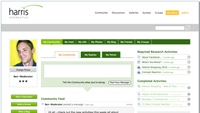
As hundreds of residents in the nation’s capital began receiving mobile DTV signals May 3 as part of the Open Mobile Video Coalition Mobile DTV Consumer Showcase, many in the television industry are looking to learn from the trial what will make the new broadcast service a hit with viewers.
The job of collecting the data needed to gain that insight is being done by Portland, OR, based media analytics firm Rentrak and market research organization Harris Interactive of New York City. The pair is tasked with two distinct but complementary research assignments.
In the simplest terms, Rentrak is charged with counting eyeballs; Harris Interactive is responsible for understanding why those eyeballs are looking at Mobile DTV content. Their findings, it is hoped, will help guide broadcasters in making Mobile DTV a success, said OMVC executive director Anne Schelle. "Our Washington Consumer Showcase of Mobile DTV is intended to characterize consumer behavior, attitudes and expectations about Mobile DTV as well as accelerate consumer interest and adoption of the technology and test various business models," she said.
For the showcase, Rentrak is working with telephone carriers to determine Mobile DTV usage — what showcase participants watch that’s being transmitted by the nine participating area broadcasters, as well as viewing patterns, such as how long they watch, when they tune in, and what they switch to next after they’re finished watching their first program choice, said Ken Papagan, Rentrak president and chief strategy officer.
“There is metadata associated with the show that you as a user are viewing, and that metadata is sent back to us via a back channel over the telecommunications network,” he said, hastening to add that the process is designed to assure anonymity of showcase participants.
“The apps serving the content keep track of what channel you are viewing, and then we translate that channel number into the program you are viewing,” added Rentrak chief information officer Amir Yazdani. “We overlay that and make sense out of it.”
Equally important to the process is determining the likes and dislikes of showcase participants, which falls to Harris Interactive. The research group is relying on an online social media model, which it has deployed with great success with food and lifestyle products, to get to that information.
The professional video industry's #1 source for news, trends and product and tech information. Sign up below.
“Individuals will be logging in in a ‘Facebook-esque’ kind of way and will be able to respond and comment to other people’s questions, comment on other people’s likes and dislikes,” said Aaron Heffron, Harris Interactive VP, public affairs research. “Then we will be mining that qualitative data to best understand how these devices do or do not become part of their daily media consumption.”
According to Heffron, Harris Interactive is creating two online communities, one each for the two separate groups of 200 participants in the showcase. One is devoted to gathering qualitative data from users of the Mobile DTV-equipped Dell netbooks in use; the other is targeted at collecting data from the Mobile DTV-enabled handset users.
The four-month data collection process began with initial discussions with OMVC and its broadcast partners in the showcase during which it was decided two areas would be examined: viewer experience focused on lifestyle and content, and viewer thoughts about technical issues related to the Mobile DTV-enabled devices used during the showcase, Heffron said.
“We’ve developed a four-month (online) discussion guide that the moderator will be engaged with and presenting certain activities for the participants to do over each week during that time period,” Heffron said. “Some will be focused on the device itself; some will be focused on where they are; and some will be focused on what they are doing at that time.”
Harris Interactive will seek out information on preferences related to screen size and type, user interface, software functions, time shifting, gather responses on user feelings about device size and weight and use or non-use of antenna, and collect data on any reception problems encountered.
“The other half really focuses on content,” Heffron said. “We will be looking at asking people what kind of programming really engages them, and what are they most likely to consume on this type of platform. This is where we’re going to be pairing our information and feedback with that from Rentrak, where we’ll be able to paint a 360 degree picture of the individual.”
Phil Kurz is a contributing editor to TV Tech. He has written about TV and video technology for more than 30 years and served as editor of three leading industry magazines. He earned a Bachelor of Journalism and a Master’s Degree in Journalism from the University of Missouri-Columbia School of Journalism.

